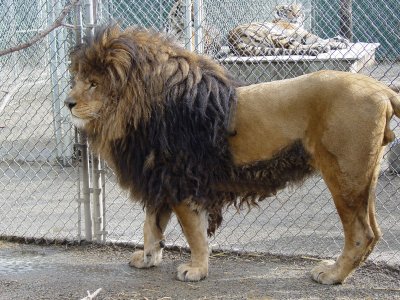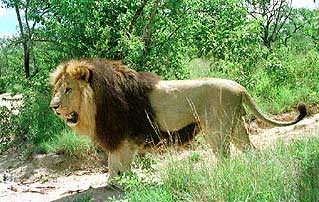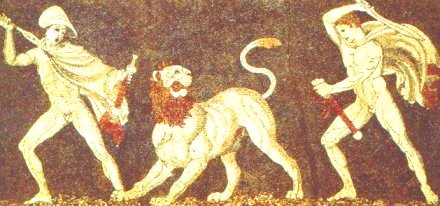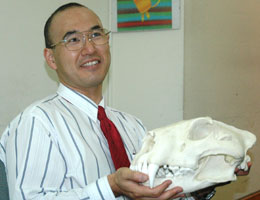Shades of Xerxes: Mystery of The Royal Lions
Posted by: Loren Coleman on February 12th, 2011

The question of lions in Europe and specifically lions in England is not a fully answered mystery. Developing answers to one set of questions may merely open the door to other riddles. When two lion skulls were found in the Tower of London’s moat during excavations in the 1930s, the precise origins of these famous “Royal Lions” were undetermined.


Barbary lions today, as shown in the two above, are ones in captivity from long lines of zoo-bred Barbary lions. The Barbary lion has been declared extinct in the wild.
Research now reveals the Tower lions were allegedly “Barbary lions,” but I want to push the inquiry beyond the obvious answer. What if these genetically-similar-to-Barbary-lions were instead Pleistocene survivors that were still to be found in merrie ole England?
It is known that the relationship between cave lions, Barbary lions, and the lions of Xerxes and Alexander were interwoven. Their physical and genetic characteristics were closer to each other than to sub-Saharan lions, except for the genetically distinct Cape Lion.

Alexander and Craterus fighting a lion. Alexander went on two such hunts, the Sidonian lion hunt (in Phoenicia, 332 BC) and the lion hunt in Basista (a.k.a. Bazaira, Sogdiana, in 328/327 BC). Herodotus recorded how Xerxes’ Persian invasion army of 480 BC was attacked by lions while bivouaking on the eastern fringes of Greece and Macedonia. (Public domain.)

Barbary lion in a 1898 picture. (Public domain.)

Asiatic Lions (Panthera leo persica). Taken by Adrian Pingstone at Bristol Zoo, England, in January 2005. (Public domain.)

An extinct Cape Lion (Panthera leo melanochaitus) in a drawing of the Dutch artist Rembrandt Harmenszoon van Rijn. XVII century. (Public domain.)


The Tower Lions skulls (above)
Independent’s Science Editor Steve Connor detailed the following 2008 findings regarding the “Royal Menagerie lions”:
A pair of lion skulls excavated from the moat around the Tower of London and dating to the medieval period belong to an extinct subspecies of Barbary lion which died out in the early 1920s, a study has found.
An analysis of the DNA extracted from the skulls has found that both lions share the same genetic traits as the large subspecies which had distinctive black manes and once lived in the Morocco region of north-west Africa until it disappeared nearly a century ago.
The two skulls were first recovered from the Tower’s moat during excavations in 1936 and 1937 but the precise geographical origin of the famous lions of the Royal Menagerie – first established by King John who reigned between 1199 and 1216 – was unknown.
“Until now we didn’t have any strong evidence that they were from North Africa. There was no documentary evidence for instance. They could have come from Asia or even from other parts of the Mediterranean,” said Richard Sabin, curator of mammals at the Natural History Museum in London.
“Lions are very charismatic large cats that have been imported into Europe for various purposes since early historic times. We’ve not known, however, until now the exact geographical origin of the animals found in London,” Dr Sabin said.
“Our results are the first genetic evidence to clearly confirm that lions found during excavations at the Tower of London originated in north Africa,” he added.
Radiocarbon tests on the skulls show that one is dated to between 1280 and 1385 and the other is dated to between 1420 and 1480. Both were young males of about three or four years of age and could have been born in the Royal Menagerie at the Tower of London rather than been shipped directly from north Africa, Dr Sabin said.
“Barbary lions were probably the largest of all the subspecies of lion. They had very long, black, shaggy manes and would have been very imposing. Visitors to the King would have had to pass through Lion Tower where the cats were kept in cages,” he said.

Nobuyuki Yamaguchi (shown above), who carried out the genetic analysis of the lions’ bones said that a contiguous population of lions once stretched from north Africa through the Middle East to India, until the growth of the Egyptian civilisation about 4,000 years ago divided the lions into separating breeding populations. “Western north Africa was the nearest region to Europe to sustain lion populations until the early 20th Century, making it an obvious and practical source for medieval merchants,” Dr Yamaguchi said.
“Apart from a tiny population in northwest India, lions had been practically exterminated outside sub-Saharan Africa by the turn of the 20th Century.”
The Royal Menagerie was first established in Woodstock near Oxford before being relocated to the Tower of London. The first residents were three leopards sent to Henry III by the Holy Roman Emperor Frederick II in 1235. It later on housed a number of exotic animals and was effectively the private zoo of successive kings and queens until it was closed by the Duke of Wellington in 1835 and the contents transferred to Regent’s Park to become London Zoo.
“Although we have one of the best mammal collections in the world here at the Natural History Museum, few physical remains survive of the Royal Menagerie,” Dr Sabin said.
“Direct animal trade between Europe and sub-Saharan Africa was not developed until the 18th Century, so our results provide new insights into the patterns of historic animal trading,” he said.

The Cape Lion depicted in a 1948 painting. (Public domain.)

In the foreground is a sub-Saharan African Lion (Panthera leo). The background felid is a representation of the American Lion (Panthera atrox).
As a Cryptomundian once commented, Xerxes’ army seemed to have been unlucky with their felines. After the defeat at Mycale the Persian survivors were harassed by tigers, which apparently still survived there in the 18th century.
About Loren Coleman
Loren Coleman is one of the world’s leading cryptozoologists, some say “the” leading living cryptozoologist. Certainly, he is acknowledged as the current living American researcher and writer who has most popularized cryptozoology in the late 20th and early 21st centuries.
Starting his fieldwork and investigations in 1960, after traveling and trekking extensively in pursuit of cryptozoological mysteries, Coleman began writing to share his experiences in 1969. An honorary member of Ivan T. Sanderson’s Society for the Investigation of the Unexplained in the 1970s, Coleman has been bestowed with similar honorary memberships of the North Idaho College Cryptozoology Club in 1983, and in subsequent years, that of the British Columbia Scientific Cryptozoology Club, CryptoSafari International, and other international organizations. He was also a Life Member and Benefactor of the International Society of Cryptozoology (now-defunct).
Loren Coleman’s daily blog, as a member of the Cryptomundo Team, served as an ongoing avenue of communication for the ever-growing body of cryptozoo news from 2005 through 2013. He returned as an infrequent contributor beginning Halloween week of 2015.
Coleman is the founder in 2003, and current director of the International Cryptozoology Museum in Portland, Maine.









